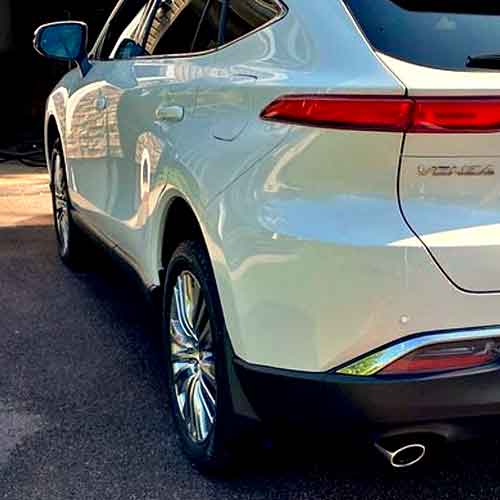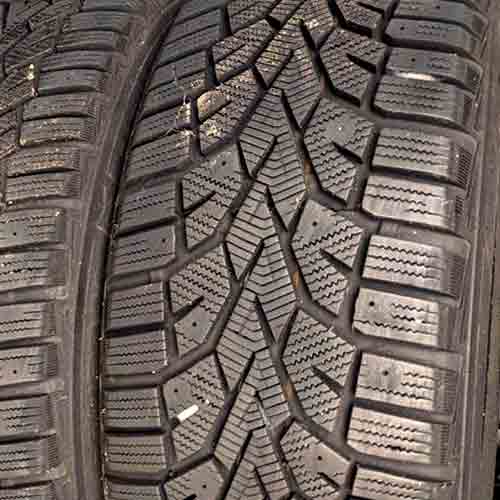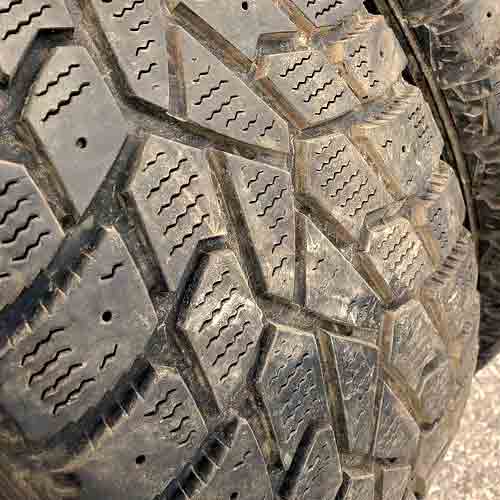Both Sumitomo Ice Edge and General AltiMax Arctic 12 are pacesetters in the winter tire industry, each displaying unique strengths in the face of frosty and snowy conditions. Let’s see which tire emerges as better pick for you!

Table of Contents
Key Takeaway
- Wet Performance: The AltiMax Arctic 12 outperforms here, due to superior water absorption and grip, especially during cornering, thanks to high-density and flexible sipes.
- Snow Grip: The Sumitomo Ice Edge excels on light, fluffy snow due to more in-groove notches and voids that trap snow particles, facilitating better snow-to-snow contact.
- Vibration Absorption: The AltiMax Arctic 12 stands out with its innovative, softer compound that absorbs surface irregularities for a smoother ride, whereas the Ice Edge’s stiffer rubber offers lesser vibration dampening.
- Noise Generation: Arctic 12’s closed-up shoulder voids and superior pitch sequencing technology, which alters tread block geometry, results in less noise generation.
- Ice Traction: Arctic 12’s angled ‘biters’, V-shaped notches, and aggressive siping pattern offer greater handling and directional traction on icy terrains.
- Dry Gripping: General tire here, with its streamlined central rib, shows superior dry grip performance, boasting an average of 4 feet shorter braking distance.
- Dry Handling: Atimax excels here in dry handlin, offering superior steering response and balanced steering.
- Tread and Fuel Usage: The AltiMax Arctic 12 leads in fuel economy and tread life due to its streamlined lugs and less aggressive central tread voids, which minimize obstructions during rolling.
Available Sizes
The Sumitomo Ice Edge comes in 14 to 20 inches with following.
- Speed ratings: T only.
- Load ratings: SL and XL.
- Tread depth: 12/32″ on all.
- Weight: 16 to 33 lbs.
On the other side, the General Altimax Arctic 12 (review) comes in 14 to 19 inches with following.
- Speed ratings: T only.
- Load ratings: XL only.
- Tread depth: 12/32″ on all.
- Weight: 16 to 35 lbs.
Dry Gripping
The efficacy of a tire’s directional grip is mainly contingent upon the central tread area, as this part of the tread gets to meet up with the road with greater force.
That’s why with a more streamlined (arrow-shaped), central most rib, which is also continuous running, the General Altimax 12 comes out on top, showcasing an average of 4 feet shorter braking distance values, upon testing.

On the other side, the Sumitomo with wider lateral groove takes the backseat here.
Dry Handling
The tire’s lateral grip or handling is dependent on the design of the shoulder lugs and overall tread flexibility.
And it gets measured with lateral g forces and lap times in testing.
And in both tests, the General Altimax is better.
The tire basically features lugs which aren’t as susceptible to bending as its counterpart. This allows for superior steering response and a more balanced over and understeering.
Wet Performance
Tire performance on wet surfaces hinges largely on the number and quality of grooves or sipes and the efficacy of the rubber tread in water absorption.
And considering these factors, the AltiMax Arctic 12 seems to have a slight edge due to its variety of sipes that are adept at superior water absorption, enabling firmer grip during all sorts of wet conditions.
This is especially notable when cornering, courtesy of the tire’s high-density, flexible, yet sturdy sipes.
In contrast, the Sumitomo Ice Edge, while still a competent performer, slightly lags behind its competitor due to less aggressive siping and a stiffer rubber composition.

Snow Grip
In the realm of snowy conditions, the tables turn in favor of the Sumitomo Ice Edge, specifically when traversing light, fluffy snow, despite its relatively weaker performance on ice and hard-packed snow.
So why is that the case?
Well, the tire basically is equipped with more in number of in-groove notches and voids, which effectively trap more snow particles, enhancing the tire’s grip by facilitating snow-to-snow contact, given that snow adheres better to itself than to rubber.
The General Altimax, although also features a lot of biters here, its overall snow holding abilities are still lower, thereby impacting its performance.
Vibration Absorption
Tires are very important when it comes to vehicle comfort. This is because these are the first one to hit the imperfections of the road.
So an absorbing tire is appreciated here.
That’s the reason why, out of both, the General AltiMax Arctic 12 stands tall due to its innovative, and softer compound, which delivers a markedly smoother ride by adeptly absorbing surface irregularities.
Whereas the Sumitomo Ice Edge, with its stiffer rubber can’t offer a better vibration dampening efficacy.
Noise Generation
Noise emission from tires primarily stems from two factors:
- When air hits the tire walls (primarily entering through shoulder voids), generating noise.
- And when that noise starts echoing within the tread, leading to in-groove resonance.
Considering both, it can be explained why the Arctic 12, with its closed-up shoulder voids, restricts air entry better, and offers less overall noise generation.
Moreover, with it also handles with noise resonance with its superior pitch sequencing technology, which alters the tread block geometry.
These alternations, account for generated tones/noise levels, with varying frequencies, which attempt to cancel each other out, resulting in a quieter tire.
Tread and Fuel Usage
The relationship between tread life and fuel economy is principally determined by rolling resistance, which is then influenced primarily by the tire’s weight, tread composition, and design.
Now in terms of fuel economy, the General AltiMax Arctic 12 outperforms with its streamlined lugs and less aggressive central tread voids.
These characteristics create a smoother, more continuous central rib, minimizing obstructions during straight-line rolling and consequently enhancing fuel economy.
In contrast, the Sumitomo Ice Edge not only lacks in fuel efficiency department, but also in the tread life.
And the reason is simple. It’s tread lugs are more susceptible to bending, and that asks for additional fuel energy.
Moreover, with this bending/rubbing on the surface of the road, extra heat gets generated.
And I think I don’t have to tell you, that the heat is the biggest enemy of winter tires, when it comes to tread life.
Ice Traction
The General AltiMax Arctic 12 demonstrates superior traction on icy terrains, owing to its more in number, and tiny ‘biters’ made up of angled cuts and V-shaped notches oriented in various directions.
And yes, on top of that, you also get more aggressive siping, which are also angled, and are the mixture of rectilinear and interlocking patterns.
All of these allow for greater handling and directional traction on Arctic 12.
On the other hand, the Sumitomo Ice Edge tends to falter due to its larger tread gaps and fewer notches.
Its siping is not aggressive and only oriented laterally.
And even if you consider its stud holes, its not as studable as the AlitMax.
To Sum Up
So what did we learn?
Well, the General AltiMax Arctic 12 tire stands out in wet performance and dry gripping. Its high-density and flexible sipes allow for superior water absorption and grip, especially during cornering.
Additionally, the tire’s streamlined central rib provides excellent dry grip, resulting in an average braking distance that is 4 feet shorter compared to its competitors.
Moreover, the AltiMax Arctic 12 offers a smooth ride with its softer compound that absorbs surface irregularities and minimizes vibration.
On the other hand, the Sumitomo Ice Edge tire excels in snow grip and dry handling. With more in-groove notches and voids, it effectively traps snow particles, enabling better snow-to-snow contact, particularly on light, fluffy snow.
When it comes to dry handling, the Ice Edge tire resists bending with its shoulder lugs, delivering superior steering response and balanced steering.
However, it falls short in wet performance and ice traction due to its larger tread gaps, fewer notches, and less aggressive siping.
Additionally, the Ice Edge tire is less fuel-efficient and has a shorter tread life compared to the AltiMax Arctic 12, as its lugs are more susceptible, requiring additional fuel energy and resulting in excess heat that reduces tread life.